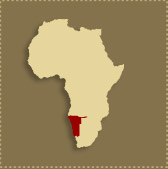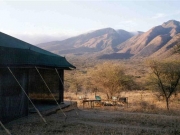Adventure Planner
Namibia
The Perfect First Safari!
HISTORY
The original inhabitants were undoubtedly Bushmen, and although Europeans explored the coastline as early as the 1500’s, the forbidding Namib Desert prevented penetration into the interior until the last century. In 1884, the country became a German colony, known as German South West, until South African troops took the area from the Germans during World War I. Following World War I, South Africa was given control of South West Africa by the League of Nations until 1990. In that year the country of Namibia became the last country on the African continent to achieve independence. Namibia is a democratically controlled country and has received many awards in recent years for human rights issues!
THE COUNTRY
A land of harsh deserts, rocky hills, and rolling savanna grasslands and thornbush, Namibia is one of the most dramatically beautiful countries on the continent. An arid country with one of the least dense human populations in all of Africa, it’s a big country with plentiful game in many areas and some game in all areas.
GAME
Greater kudu are extremely plentiful and of excellent quality, arguably Africa’s best. Namibia also offers Africa’s best gemsbok, largest springbok, superb red Cape hartebeest, loads of warthog and ostrich, plus steenbok, Damaraland dik-dik, and grey duiker. Some areas offer quite good Cape eland and the beautiful Hartmann’s mountain zebra, one of Namibia’s most challenging trophies. In addition, waterbuck, bontebok, roan, sable, nyala, blue wildebeest, black wildebeest, blesbok, Burchell’s zebra, and impala have been introduced or reintroduced into numerous areas. Cheetah are fairly plentiful and, although very difficult to hunt, are huntable but not importable to the United States. Small predators like the caracal (African lynx) and jackals are quite plentiful and often make a bonus trophy. This may have been the best country in all of Africa for Leopard via baiting or with hounds. Elephant, Lion, and buffalo are available in a few concessions.
HUNTING CONDITIONS & AREAS
Namibia offers some of the most pleasant hunting in Africa. Much of the country was broken into large homestead estates for German settlers, and this grid of private lands still offers some of the country’s finest hunting.
Although it is indeed ranch hunting, game fences are rare and the “farms,” as they are locally called, are quite large. Species like kudu, hartebeest, gemsbok, springbok, and Hartmann’s mountain zebra generally occur naturally, undoubtedly made more plentiful by the permanent water sources developed by ranchers.
Typical accommodations are guest quarters on a ranch, a permanent safari camp established by ranchers, or traditional tent camps in undeveloped regions. Guest quarters must be government-inspected and approved, and can be expected to be very comfortable lodge-style, with separate rooms and private bath, and skilled chefs. A swimming pool for a midday plunge is perfect for non-hunters! Those who like to view a vast variety of wild birds will be thrilled. Most areas offer virtually all the indigenous species.
Namibia can be divided into four hunting zones, Northern, Central, and Kalahari, and the Caprivi Strip in the far northeast. The Northern and Central zones offer a complete bag of all plains game with leopard and cheetah. The Kalahari region has the largest gemsbok, over 40 inches being common! The Caprivi Strip is a government concessions and conservancies, which is leased by auction and offers Namibia’s best dangerous game hunting. Good lion, leopard, buffalo and elephant can be hunted and then combined with plains game areas in the south for a full bag. Combining more than one area requires at least a half-day of travel. A safari in the Caprivi generally requires air charter.
Besides private land Safari Destinations both communal conservancies and government owned concessions are in developmental stages. Communal conservancies are gerally tribal owned and quite large and million of acres. Government concessions are being developed, most of these areas offer expanded dangerous game hunting and are found in the Caprivi Strip of Namibia.



